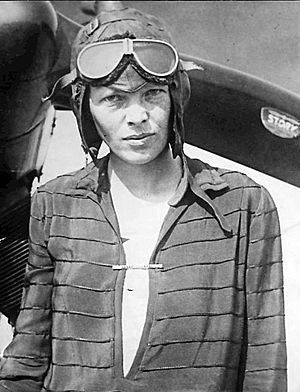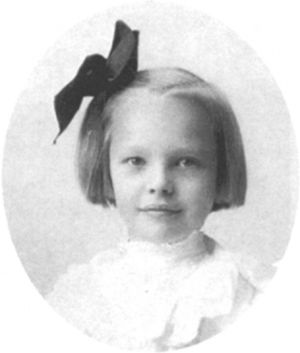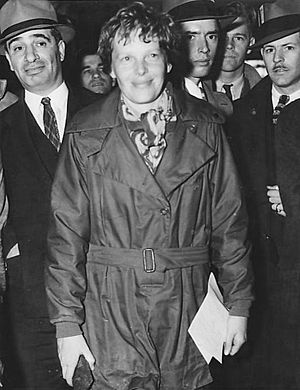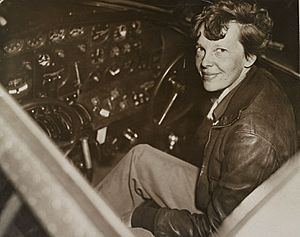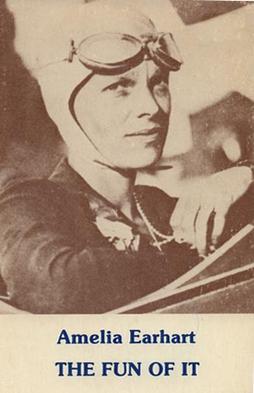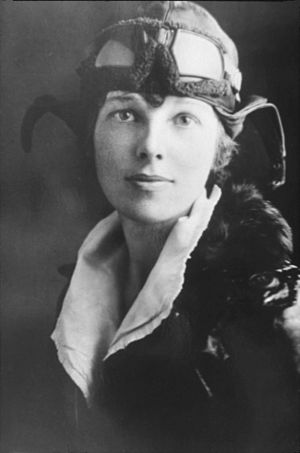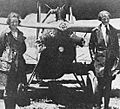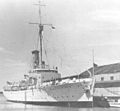Amelia Earhart facts for kids
Quick facts for kids
Amelia Earhart
|
|
|---|---|
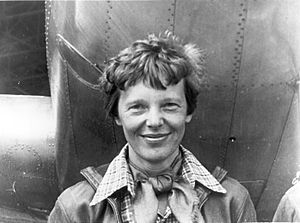
Earhart beneath the nose of her Lockheed Model 10-E Electra, March 1937, Oakland, California
|
|
| Born |
Amelia Mary Earhart
July 24, 1897 Atchison, Kansas, U.S.
|
| Disappeared | July 2, 1937 (aged 39) Pacific Ocean, en route to Howland Island from Lae, Papua New Guinea |
| Status | Declared dead in absentia January 5, 1939 (aged 41) |
| Known for | Many early aviation records, including first woman to fly solo across the Atlantic Ocean |
| Spouse(s) | |
| Signature | |
 |
|
Amelia Mary Earhart (born July 24, 1897; disappeared July 2, 1937) was an American aviation pioneer and author.
Earhart was the first female aviator (pilot) to fly solo across the Atlantic Ocean. She set many other records, wrote best-selling books about her flying experiences, and played a large part in the formation of The Ninety-Nines, an organization for female pilots.
Born in Atchison, Kansas, Earhart developed a passion for adventure at a young age, steadily gaining flying experience from her twenties. In 1928, Earhart became the first female passenger to cross the Atlantic by airplane accompanying pilot Wilmer Stultz. This is part of what made her famous.
In 1932, piloting a Lockheed Vega 5B, Earhart made a nonstop solo transatlantic flight, becoming the first woman to achieve such a feat. She received the United States Distinguished Flying Cross for this accomplishment.
In 1935, Earhart became a visiting faculty member at Purdue University as an advisor to Purdue University School of aeronautical engineering and a career counselor to women students. She was also a member of the National Woman's Party and an early supporter of the Equal Rights Amendment.
During an attempt to make a circumnavigational flight of the globe in 1937 in a Purdue-funded Lockheed Model 10-E Electra, Earhart and navigator Fred Noonan disappeared over the central Pacific Ocean near Howland Island. She was declared dead on January 5, 1939.
Contents
Background
Amelia Earhart's parents encouraged her from a young age to participate in activities usually left to boys, such as football, baseball, and fishing in her hometown of Atchison, Kansas. Receiving their encouragement, watching numerous air shows in Los Angeles, and paying a pilot a dollar for a 10-minute airplane ride all contributed to her decision to become a pilot and join this mainly male field. After her first ride, she wrote, "By the time I had gotten two or three hundred feet off the ground, I knew I had to fly."
From 1921 to 1922, Earhart was taught to fly by Neta Snook, the first woman to graduate from the Curtis School of Aviation. In October 1922, Earhart received her pilot's license from the Federation Aeronatique Internationale. Soon after, on October 22, 1922, Earhart set a women's altitude record of 14,000 feet (4,200 meters) in a Kinner Canary, an open-cockpit, single-engine biplane.
Charles Lindbergh made his record-setting solo flight across the Atlantic Ocean in 1927. One of the people inspired by his feat was flying enthusiast Amy Guest, who hoped to be the first woman to cross the Atlantic. She purchased a plane but her family stopped the trip.
Earhart went in her place and became the first female to cross the Atlantic Ocean. Leaving Newfoundland, Canada, on June 4, 1928, Earhart joined Wilmer L. Stutz and Louis E. Gordon in their bright red Fokker F.VII named the Friendship on their 2,000-mile (3,219-kilometer) trip to Wales. Earhart had no part in piloting the plane during the 20-hour, 40-minute trip and was, in her words, "just baggage," making her even more eager to cross the Atlantic on her own.

In 1929, Earhart co-founded an organization whose goal was to advance women's participation and opportunities in aviation. Called the Ninety-Nines, the organization was composed of 99 charter members, representing 99 of the 117 licensed women pilots in the United States at the time.
Earhart continued setting records. On July 6, 1930, she set a woman's speed record of 181 miles per hour (291 kilometers per hour), in a Lockheed Vega, a single-engine monoplane. On April 8, 1931, she set an autogiro (similar to a helicopter) altitude record of 18,451 feet (5,623.8 meters).
First solo Atlantic flight
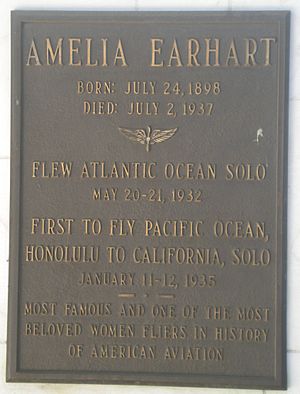
On May 20–21, 1932, Earhart accomplished her goal of flying solo across the Atlantic Ocean. She took off from Newfoundland, Canada, at 7:12 p.m. on May 20, in her Lockheed Vega. Her flight was filled with dangers, from rapidly changing weather, to a broken altimeter (so she could not tell how high she was flying), to gasoline leaking into the cockpit. At one point her plane dropped almost 3,000 feet (914 meters) and went into a spin (which she managed to pull out of) and flames were shooting out of the exhaust manifold.
She brought her plane down on the coast of Ireland after a harrowing trip that lasted 15 hours, 18 minutes. The flight was the second solo flight across the Atlantic and the longest nonstop flight by a woman—2,026 miles (3,261 kilometers)--as well as the first flight across the Atlantic by a woman.
President Herbert Hoover awarded her the National Geographic Society Medal on June 21, 1932, for her achievement, and the U.S. Congress awarded her the Distinguished Flying Cross, the first woman to receive such an honor. Earhart's accomplishment meant a great deal to the entire world, but especially to women, for it demonstrated that women could set their own course in aviation and other fields.
Other achievements
Her next major achievement was to set the women's nonstop transcontinental speed record. On August 24–25, 1932, she flew from Los Angeles, California, to Newark, New Jersey, in a record 19 hours, 5 minutes, flying a Lockheed Vega, also becoming the first woman to fly solo coast-to-coast. The next July, she flew the same flight; this time she did it in 17 hours, 7 minutes and set a new transcontinental speed record.
In January 1935, Earhart became the first woman to make a solo long-distance flight over the Pacific Ocean, flying from Honolulu, Hawaii, to San Francisco, California. This complicated flight in her second Lockheed Vega occurred in adverse weather conditions and demonstrated Earhart's courage as well as her stubbornness.
She followed that flight with two more first solo flights—one on April 19–20 from Los Angeles, California, to Mexico City, in 13 hours, 23 minutes and the second on May 8, 1935, from Mexico City to Newark, New Jersey, in 14 hours, 19 minutes.
Flight around the world
Earhart wanted to be the first of either gender to fly around the world at its widest, close to the equator. She got the most advanced long-range, non-military aircraft available—a Lockheed Model 10E Electra. The all-metal, two-engine plane had been reconfigured with extra fuel tanks replacing the passenger seats, allowing the plane to travel farther between refueling.
Her first attempt at the world flight began on March 17, 1937, in Oakland, California, but ended abruptly with a runway crash in Honolulu, Hawaii, after a tire blew and a shock absorber on the landing gear failed. Earhart decided to repair the damaged plane and try again.
Her next try began on May 20, 1937, this time heading from Oakland to Miami, Florida. However, the plane had mechanical problems along the way that resulted in further delays. Eventually, she and Fred Noonan, her navigator, reached Miami and made final adjustments to the plane's engines and instruments. Finally, Earhart and Noonan were ready to depart.
What turned out to be the final flight of Earhart's career, and, ultimately, her life, began on June 1, 1937. Earhart and Noonan left for their round-the-world flight from Miami, Florida, in her twin-engine, red-winged Electra. From Miami, they flew to San Juan, Puerto Rico.
Right before taking off on this leg of the flight, Earhart was quoted as saying, "I have a feeling there is just about one more good flight left in my system and I hope this trip is it. Anyway, when I have finished this job, I mean to give up long-distance 'stunt' flying."
Disappearance
As Earhart's journey continued, news of her flight made the front page of newspapers around the world. She sent reports of the land, cultures, and people she encountered. On June 30, 1937, Earhart and Noonan arrived in Lae, New Guinea. They had traveled 22,000 miles (35,406 kilometers) and had 7,000 miles (11,265 kilometers) left to go.
Their next destination, and the most dangerous stop of the trip, was Howland Island, a tiny island in the Pacific Ocean, 2,556 miles (4,113 kilometers) away. Before Earhart took off from Lae on July 1, there was confusion about which radio frequencies were to be used. This did not get solved before she took off.
As the scheduled time neared for Earhart to approach the island, several transmissions were received from her, demanding to know the weather. A new weather report describing heavy clouds and rain northwest of Howland had been issued, and Earhart had run into the storm. Earhart transmitted several more times but never reached her destination, disappearing somewhere off the coast of the island.
A large search party was quickly organized, but no remains of the crew and the plane were ever found.
There are many theories surrounding the controversial disappearance of Earhart's plane on July 2, 1937. Most researchers believe that Earhart and Noonan got lost, ran out of gas, and went down somewhere in the Pacific Ocean. However, two other theories have grown in the years since, one involving capture and execution as spies by the Japanese, and the other dying of exposure after landing on a deserted island.
Possible discovery of Electra
In 2024, Deep Sea Vision, a Charleston, South Carolina, company that operates unmanned underwater vehicles, found via sonar what appears to be the remains of an airplane on the ocean floor. The object, shaped like the Electra, was detected by the Hugin submersible 16,000 ft (4.9 km) underwater and within 100 mi (160 km) of Howland Island. More exploration is necessary to confirm whether this is Earhart's missing aircraft.
Legacy
Although only 39 when she disappeared, Earhart accomplished a great deal and is considered a true hero of the 20th century, especially for women. She demonstrated courage, integrity, and an independent spirit.
She used her fame to advance the cause of women and showed that a determined woman could achieve anything. Her efforts led a generation of women to seek new horizons and new roles for themselves.
Books by Earhart
Amelia Earhart was an accomplished writer who served as aviation editor for Cosmopolitan magazine from 1928 to 1930. She authored numerous magazine articles and essays, and published two books based on her experiences as a flyer during her lifetime:
- 20 Hrs., 40 Min. was her journal of her 1928 flight across the Atlantic as a passenger, making her the first woman to make such a journey.
- The Fun of It was a diary/memoir of her flying experiences, as well as an essay on women in aviation.
A third book credited to Earhart, Last Flight, was published following her disappearance and featured journal entries she made in the weeks before her final departure from New Guinea.
Amelia Earhart quotes
- "Adventure is worthwhile in itself."
- "I have often said that the lure of flying is the lure of beauty."
- "Never interrupt someone doing what you said couldn't be done."
- "Mostly, my flying has been solo, but the preparation for it wasn't. Without my husband's help and encouragement, I could not have attempted what I have."
- “Worry retards reaction and makes clear-cut decisions impossible.”
Interesting facts about Amelia Earhart
- Amelia called her sister Grace "Pidge" and her sister called her "Meely." They continued this through their adulthood.
- Amelia once built a ramp off the top of a toolshed and said that she felt like she was flying.
- Amelia dropped out of school to volunteer as a nurse for World War I soldiers.
- She did not like coffee or tea but preferred hot chocolate.
- Amelia was one of the first celebrities to create her own fashion line, a trend that is popular among celebrities today.
- She encouraged other women to fly.
- After Amelia disappeared, America spent $4 million looking for her.
- There is another Amelia Earhart who became the youngest woman to fly around the world in a single-engine plane in 2014.
Questions kids ask about Amelia Earhart
How did Amelia Earhart die?
Since they never found her they couldn't say for certain, but two years after she went missing they said that her plane had probably crashed in the Pacific Ocean and she had drowned.
How old would Amelia Earhart be today?
Amelia would be 127 years old today.
Was Amelia Earhart's plane ever found?
No trace of her plane has ever been found. In 2019, the explorer who found the Titanic, Robert Ballard, went searching for the plane and he found no hint of it.
Where did Amelia Earhart disappear?
Amelia and her navigator disappeared somewhere over the Pacific Ocean.
What island did Amelia Earhart crash on?
Howland Island was the island in the central Pacific Ocean where they thought Amelia may have crashed. She was trying to locate the island when she disappeared.
Did Amelia Earhart have kids?
Amelia didn't have any children of her own but did have two step-children.
What were Amelia's last words?
Her last message was Amelia giving compass headings to the Coast Guard cutter Itasca that was near Howland Island that was helping her during her flight. "We are on the line 157 337. We will repeat this message. We will repeat this on 6210 kilocycles. Wait..."
Did Amelia Earhart survive the crash?
Amelia and her navigator, Fred Noonan may have survived a crash landing.
Images for kids
-
Earhart perched atop the dome of Low Memorial Library at Columbia in 1920. Earhart recalled in a 1933 interview, that "The first adventure I had at Columbia was in the air. I climbed to the top of the Library and then I descended into the intricate tunnels."
-
L–R: Neta Snook, Earhart's Kinner Airster and Amelia Earhart, c. 1921
-
Commemoration Stone for Amelia Earhart's 1928 transatlantic flight, next to the quay side in Burry Port, Wales
-
Earhart walking with President Hoover in the grounds of the White House on January 2, 1932
-
Lockheed Vega 5B flown by Amelia Earhart as seen on display at the National Air and Space Museum
-
"Earhart Light" on Howland Island in August 2008
See also
 In Spanish: Amelia Earhart para niños
In Spanish: Amelia Earhart para niños


